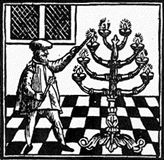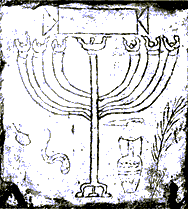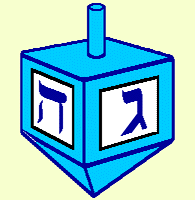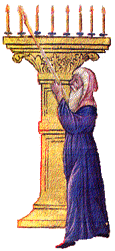
CHANUKKAH
WITH THIS PICTURE? Click for Answer |

|
Amsterdam, 1707 CE. |
The Festival celebrates an event in history that is well documented. After Alexander the Great's conquests in Asia around 332 BCE, Judea came under Greek control and remained so for more than 150 years. Eventually when Antiochus IV known as Epiphanes (great) was ruling the country, he tried to enforce the Greek religion in his territory and this aroused such strong feelings that the Jewish population rose in revolt. Antiochus wanted to unify all the various peoples under his control and tried to do this by making them speak Greek, observe Greek customs and by forbidding the practice of the Jewish religion. He took over the Temple and ordered pagan sacrifices to be offered there.
In 167 BCE, the revolt began in a small town called Modin. It was led by an elderly priest called Mattathias assisted by his five sons. When he died about a year later, his son Judah Maccabee (from  Macav meaning hammer) became leader. He carried out a very successful campaign of guerrilla warfare. The small band of ill-trained and ill-equipped Jews, although greatly outnumbered, miraculously managed to defeat the highly trained armies of professional soldiers sent against them on several occasions. They eventually liberated Jerusalem and rededicated the Temple. And it is this rededication that is commemorated and gave the name Chanukkah.
Macav meaning hammer) became leader. He carried out a very successful campaign of guerrilla warfare. The small band of ill-trained and ill-equipped Jews, although greatly outnumbered, miraculously managed to defeat the highly trained armies of professional soldiers sent against them on several occasions. They eventually liberated Jerusalem and rededicated the Temple. And it is this rededication that is commemorated and gave the name Chanukkah.
THE EARLIEST ACCOUNTS.
The earliest account of what happened, possibly by an eye witness, was written in Hebrew about 30 years after the event and says simply:
They made new holy vessels, and brought the lamp stand, the altar of incense and the table into the temple. Then they offered incense on the altar and lit the lights on the lamp stand and these gave light in the temple� they dedicated it on the very day that it had been profaned, it was dedicated with songs and harps and lutes and cymbals � They celebrated the dedication of the altar for eight days.1.
In this initial account, the lamp does not appear to play a more important part than the incense altar or the table for the shewbread. The only special thing about it, was that it provided light inside the temple.
The next account is thought to have been written in Greek about 50 or so years after the event added some extra details:
The sanctuary was purified on the twenty-fifth of Kislev, the same day of the same month as that on which the foreigners had profaned it. The joyful celebration lasted for eight days; it was like the Feast of Tabernacles, for they recalled how, only a short time before, they had kept that feast while they were living like wild animals in the mountains and caves; and so they carried garlanded wands and branches with their fruits, as well as palm fronds, and they chanted hymns to the One who had so triumphantly had achieved the purification of His own temple.2.
(1.) 1 Macc 4, vs. 49, 54 and 59 (2.) 2 Macc. 10, 5 - 7.
DEVELOPMENT OF THE FESTIVAL.

|
c. 1st Cent. CE. |
Reading these early accounts, most of us would immediately notice that there is no mention of the well-known story about the oil that lasted eight days. Josephus, writing about 250 years after the event, gives a very similar account. For him, the lamp stand is still not an especially important feature of the festival. He does not yet know the Festival by the name Chanukkah, instead he calls it the Festival of Lights. Whiston's translation says "I suppose the reason was because this liberty beyond our hopes appeared to us; and that thence was the name given to that festival.3." He appears to be uncertain about the reason for light. He seems to think it is probably connected with the light of liberty.
By the time of the Mishnah, about 370 years after the revolt, the festival has become known by the name Chanukkah, but it is only mentioned in passing and no rules are laid down for its observance. There is a reference to Chanukah lights4., but this tells us almost nothing about the ritual observance.
(3.) Antiquities, 12, 7, #6 and #7. (4.) Baba Kama 6, 6.
THE MIRACLE OF THE OIL.
It was not until the Babylonian Talmud was completed in the fifth century CE that we find the story about the jar of oil that lasted eight days. That is approximately 600 years after Judah the Maccabee. The Talmud says:
What is the reason for Hanukkah? For our Rabbis taught: On the twenty-fifth of Kislev commence the days of Hanukkah, which are eight on which a lamentation for the dead and fasting are forbidden. For when the Greeks entered the Temple, they defiled all the oils therein, and when the Hasmonean dynasty prevailed against and defeated them, they made search and found only one cruse of oil which lay with the seal of the High Priest, but which contained sufficient for one day's lighting only; yet a miracle was wrought therein and they lit the lamp therewith for eight days. The following year these days were appointed a Festival with the recital of Hallel and thanksgiving.5.
WHY THE OIL STORY?
The story about the miraculous oil must have been written by the Amoraim (Rabbis of the Talmudic period) between the years 210 and 500 CE. Two possible reasons why they introduced this were:
- The Pharisaic Rabbis used to base their laws and practices on Biblical verses to give them divine authority. But the events which Chanukkah commemorates occurred after the Hebrew Bible was completed. The only way left to make the Festival important was to give it a miracle story.
- The practice of lighting Chanukkah lights was often being mixed up in peoples' minds with an even older pagan mid-winter festival. So the Rabbis wanted to give the lights Jewish significance and meaning. The Talmud says:
Our Rabbis taught: When Adam saw the day getting gradually shorter, he said, �Woe is me, perhaps because I have sinned, the world around me is being darkened and returning to its state of chaos and confusion; this then is the kind of death to which I have been sentenced from Heaven!� So he began keeping an eight days� fast. But as he observed mid-winter's day and noted the day getting increasingly longer, he said, �This is the world's course�, and he set forth to keep an eight days� festivity. In the following year he appointed both as festivals. Now, he fixed them for the sake of Heaven, but the heathens appointed them for the sake of idolatry.6.

Newgrange (Ancient tomb), Ireland c. 3000 BCE.
Built so sunlight enters at dawn on mid-winter's day.The Talmud naturally says that the Jewish observance came first. But archaeological evidence shows that from very ancient times midwinter's day was kept by special observances. In Egypt, some pyramids were aligned to the rising sun on mid-winter's day. While in the Britain, the tombs at Maes Howe on Orkney and Newgrange in Ireland were observing the phenomenon from about 3000 BCE.
(5.) Shabbat 21b. (6.) Avodah Zarah 8a.
THE REAL MIRACLE OF CHANUKKAH.
Our prayers and blessings during the festival refer to the  nissim miracles which occurred at Chanukkah. If these do not refer to the legend of the oil, what do they refer to? When a small group of Jews in a little village revolted against the might of King Antiochus and his Greek Syrian empire with its large fully trained army, nobody thought that they could win. After all, the Jews had not had an army or even fought a battle for over 300 years. And yet these untrained inexperienced peasants defeated large armies of battle-hardened soldiers in battle after battle. That was surely a great miracle. How was this achieved? The Jews fought for freedom to worship in the way that they chose and for freedom from oppression. Their enemies were mainly mercenary soldiers who fought to win booty and spoil from those they defeated. The fact that the Maccabees were inspired by an ideal, strengthened their resolve to such an extent, that they had in them a spirit and will to win, that carried them to victory. This inspiration was a spiritual miracle, and as such, was far greater than the physical miracle or Divine conjuring trick that was supposed to make one jar of oil last for eight days.
nissim miracles which occurred at Chanukkah. If these do not refer to the legend of the oil, what do they refer to? When a small group of Jews in a little village revolted against the might of King Antiochus and his Greek Syrian empire with its large fully trained army, nobody thought that they could win. After all, the Jews had not had an army or even fought a battle for over 300 years. And yet these untrained inexperienced peasants defeated large armies of battle-hardened soldiers in battle after battle. That was surely a great miracle. How was this achieved? The Jews fought for freedom to worship in the way that they chose and for freedom from oppression. Their enemies were mainly mercenary soldiers who fought to win booty and spoil from those they defeated. The fact that the Maccabees were inspired by an ideal, strengthened their resolve to such an extent, that they had in them a spirit and will to win, that carried them to victory. This inspiration was a spiritual miracle, and as such, was far greater than the physical miracle or Divine conjuring trick that was supposed to make one jar of oil last for eight days.
WHY EIGHT DAYS?
As the oil story is probably unhistorical, why then does the festival last eight days? The two earliest sources give reasons. The second book of Maccabees 7.says that this was because the Jews had not been able to keep Succot while hiding in the hills so they celebrated it late and ordered later generations to have an eight day festival at this time. The first book of Maccabees 8.does not mention this reason, but just says that they kept a celebration of rededicating the altar for eight days and that in future this should be kept each year.
(7.) 2 Maccabees, 10, 6. (8.) 1 Maccabees, 4, vs. 56 and 59.

CHANUKIAH.
The special lamp used on Chanukkah is called  Chanukiah. Originally this was oil-burning, but in recent years, most are made to hold candles. These lamps usually have eight candle arranged in a straight line, and there is a ninth one which is on a different level, which is used to light the other eight. This candle is called the
Chanukiah. Originally this was oil-burning, but in recent years, most are made to hold candles. These lamps usually have eight candle arranged in a straight line, and there is a ninth one which is on a different level, which is used to light the other eight. This candle is called the  Shamash. (The Shamash in the synagogue has the job of arranging everything so that the service runs smoothly.) The reason for eight lights is for the eight days of Chanukkah. (See EARLIEST ACCOUNTS., MIRACLE OF THE OIL.) Originally the lamp in the Temple had seven branches. The Rabbis said however that once the temple had been destroyed, it was forbidden to make copies of Temple ritual objects. The eight-candle menorah might therefore have developed because of this rule.
Shamash. (The Shamash in the synagogue has the job of arranging everything so that the service runs smoothly.) The reason for eight lights is for the eight days of Chanukkah. (See EARLIEST ACCOUNTS., MIRACLE OF THE OIL.) Originally the lamp in the Temple had seven branches. The Rabbis said however that once the temple had been destroyed, it was forbidden to make copies of Temple ritual objects. The eight-candle menorah might therefore have developed because of this rule.
WHERE TO LIGHT.
Because the lighting is in memory of a miraculous event it was felt that we should give it maximum publicity. So Talmudic Rabbis said: It is incumbent to place the Hanukkah lamp by the door of one's house on the outside; if one dwells in an upper chamber, he places it at the window nearest the street. But in times of danger it is sufficient to place it on the table.9. As a result of anti-Semitism, it has become the practice to light them indoors. If one does light the chanukiah outside, then it should be placed on the opposite side of the door to the mezuzah.10.
(9.) Shabbat 21b. (10.) Ganzfried 3, 139, #7.
HOW TO LIGHT.
In the Talmud Rab said, One may not kindle one light from another light11.. And Raba said: Another lamp is required for its light to be used.12. These rulings gave rise to the ninth light on the Chanukiah, which is called the Shamash and which is used to light the other lights. The light of the Shamash may be used for secular purposes. The passage  Hanerot Hallalu, (These Lights), which is read or sung on Chanukah refers to these legal rulings.
Hanerot Hallalu, (These Lights), which is read or sung on Chanukah refers to these legal rulings.
One light is added to the Chanukiah each night. Candles are put in from right to left as Hebrew script goes that way. But the practice is to light the new candle first and light from left to right. (See CANDLE-LIGHTING DEMO.) On Friday night, the Chanukiah is lit before the Sabbath candles, as it was forbidden to kindle lights once the Sabbath had started. Two blessings are said or sung before lighting, except on the first night when a third, the  shehechiyanu is added.
shehechiyanu is added.
(11.) Menachot 41b. (12.) Shabbat 21b.
 | CANDLE LIGHTING DEMO. |
INCREASING LIGHT.
The Talmud says that in Mishnaic times there was discussion as to how to light the Chanukkah candles. The school of Shammai maintain: On the first day eight lights are lit and thereafter they are gradually reduced; but the school of Hillel say: On the first day one is lit and thereafter they are progressively increased.13. The views of the school of Hillel were accepted. The reasons given for them was that we increase in [matters of] sanctity but do not reduce.14.
Another more likely reason for increasing the number of lights is that they symbolise the fact that after mid-winter's day the daylight hours are getting longer. It is therefore probable that this kindling of lights is a Jewish adaptation of a secular mid-winter festival that already existed. (See also WHY THE OIL STORY?) But Judaism linked it with an historical event, and made its theme the preservation of the freedom to worship in the way that the individual believes to be right.
(13.) Shabbat 21b. (14.) Ibid.


|
Germany, 1820 CE. Note Oil-burning Chanukiah top left. |
PLAYING GAMES.
To pass the time in the long mid-winter evenings, many people played cards and other games. Gradually card-playing became associated with Chanukkah. In several books Chanukkah was illustrated by card-playing rather than by lighting the Chanukiah. See picture on right, which was one of a set of nine illustrating important dates in the calendar. All the others show a religious practice connected with the festival; but for Chanukkah they highlight card playing. The menorah is shown in the background, while the card playing occupy the centre of the picture..
NEW EMPHASIS OF CHANUKKAH.
By 1871, Chanukkah was so little observed that the Reform Rabbis meeting at the Augsburg Synod decided it was necessary to re-emphasise it�s religious significance15.. With the founding of the Zionist movement in 1897 and the need for the early settlers in Palestine to defend themselves against attack, Jews began to see soldiers as standing up for freedom and right. The old images in the Haggadah of the wicked son being represented as a soldier were passing. So in the 20th century, Chanukah became a much more important festival. This was particularly noticeable in the years leading up to the foundation of the state of Israel.
(15.) Philipson: The Reform Movement in Judaism, (1931) pp. 321-2.
DREIDEL.

|
(requires Javascript) |
One of the games which children were encouraged to play on Chanukkah was the Dreidel. A Dreidel is a four sided spinning top. On the four sides are the Hebrew letters Nun, He, Gimel and Shin. In Hebrew they were taken to be the initial letters of the Hebrew words  Ness Gadol Hayah Sham, meaning "a great miracle happened there." The miracle was usually explained to children as being concerning oil, and this led to the prevalent belief among adults.
Ness Gadol Hayah Sham, meaning "a great miracle happened there." The miracle was usually explained to children as being concerning oil, and this led to the prevalent belief among adults.
Rules of the Game.
The Yiddish explanation for the letters supplied the rules of the game. This is a small time gambling game usually played with match-sticks or sweets, etc. Each player puts in one token into the kitty. And players take it in turns to spin the dreidel. When someone wins the whole kitty, then players start it off again by putting in one each. The letter HE means the player wins half the kitty and the SHIN means that he puts one into the kitty. See the following table.
 |  |  |  | |
| HEBREW |  |
 |
 |
 |
| LETTER NAME | NUN | GIMEL | HE | SHIN |
| HEBREW WORD | NES | GADOL | HAYAH | SHAM |
| TRANSLATION | MIRACLE | GREAT | HAPPENED | THERE |
| YIDDISH WORD | NISHT | GANTZ | HALB | STELL |
| TRANSLATION | NOTHING | GAINS (ALL) | HALF | PUTS (IN) |
CHANUKKAH FOOD.
During the middle ages it was usual to have cheese dishes like cheese pancakes during the festival. The reason for this was that Judith in the Apocryphal book of that name was associated in Jewish Legends with the Maccabees, and Judith was supposed to have eaten cheese foods before killing Holofernes the Assyrian general.
Today, the foods most associated with Chanukkah are potato latkes (pancakes) and doughnuts. This is because both of these foods are cooked in oil, which reminds us of the oil story. (Well, at least, that is our excuse for eating them.) None of these foods are ritually required to be eaten they are just associated with the season.

CHANUKKAH GELT.
It is usual to give presents to the children at Chanukkah. One long standing tradition was to give Chanukkah Gelt (Yiddish for money). Very often the amount given was a multiple of 44. This is because 44 is the number of candles required to light the chanukiah, if one counts in the shamash.


|
Italy, 1485 CE. |
WHAT IS WRONG WITH THAT PICTURE.
The eight lights should be on the same level, as shown in this Italian illustration.16. As in this picture, there appears to be no shamash candle. (The man in this one is using a long taper in a holder to light the candles.)
(16.) Ganzfried 3, 139, #9.
| FOR FULL ALPHABETICAL INDEX |
 Chanukkah (the word has various spellings in English transliteration such as Hanukah, Chanukah, etc), means Dedication. This festival commemorates the events recorded in the 1st and 2nd books of Maccabees that took place in 165 BCE, when the Temple was rededicated after Greek-Syrian occupation. These books are Jewish writings preserved in the
Chanukkah (the word has various spellings in English transliteration such as Hanukah, Chanukah, etc), means Dedication. This festival commemorates the events recorded in the 1st and 2nd books of Maccabees that took place in 165 BCE, when the Temple was rededicated after Greek-Syrian occupation. These books are Jewish writings preserved in the